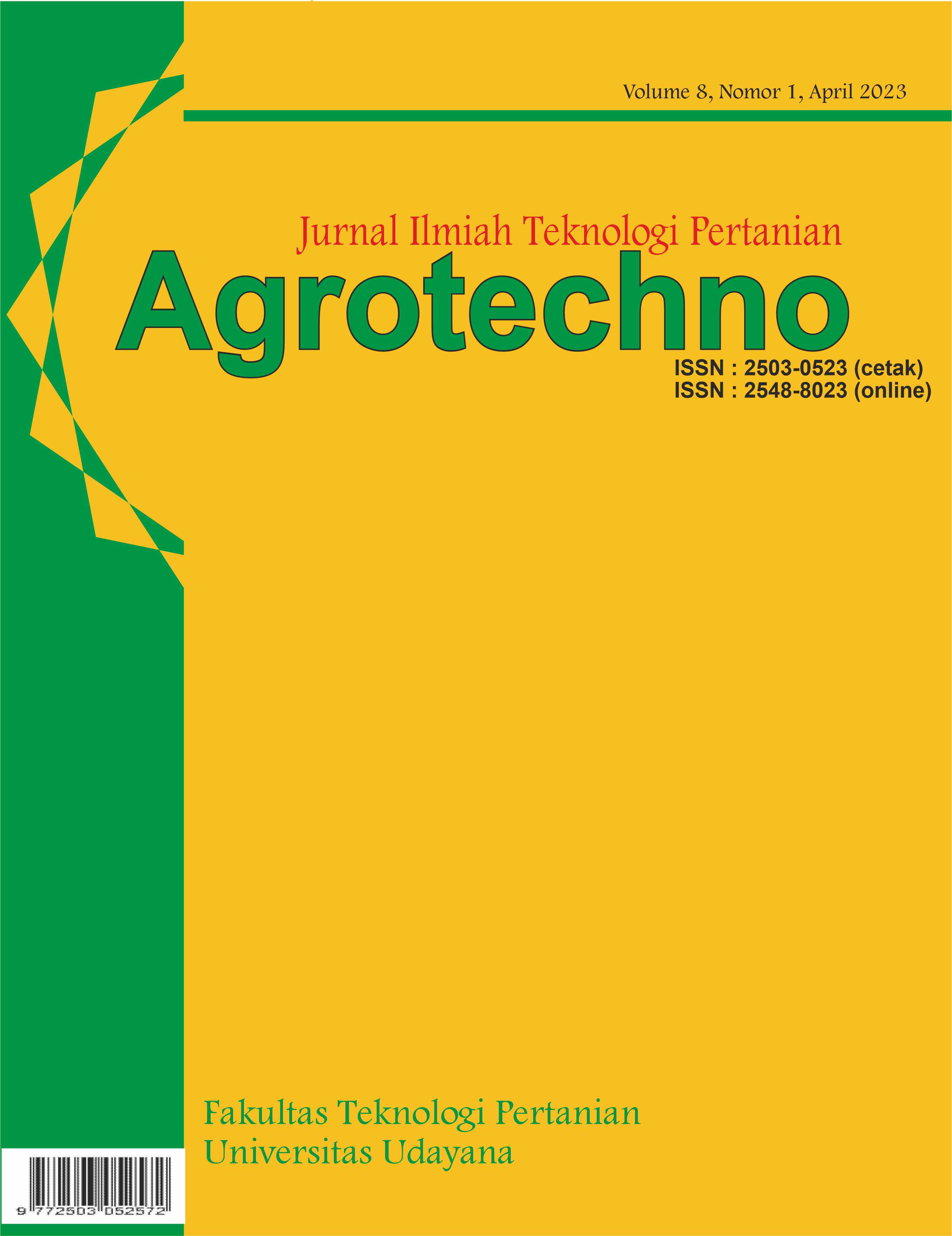Penerapan Metode Qualitty Function Deployment untuk Upaya Peningkatan Mutu Komoditi Bawang Merah (Allium ascalonicum) Varietas Lokal Kintamani
Abstract
Salah satu pesaing utama komoditi bawang merah Kintamani adalah bawang merah Brebes. Pangsa pasar bawang merah Brebes lebih besar di bandingkan Kintamani baik pada level lokal Bali maupun nasional. Peningatan mutu komoditi bawah merah Kintamani perlu dilakukan melalui serangkaian perbaikan teknis budidaya agar lebih sesuai dengan kebutuhan dan keinginan konsumen. Tujuan penelitian ini adalah untuk mengetahui kriteria atribut produk bawang merah yang dibutuhkan dan diinginkan oleh konsumen, pembobotan mutu komoditi bawang merah Kintamani dibandingkan bawang merah Brebes, dan aktivitas perbaikan yang harus dilakukan petani Kintamani. Penelitian ini menggunakan metode Quality Fuction Deployment (QFD) dengan alat analisis yaitu matriks House of Quality. Kualitas bawang merah dievaluasi berdasarkan 6 jenis atribut mutu, yaitu kebersihan umbi, warna umbi, ukuran umbi, kesegaran umbi, tidak ada kebusukan pada umbi, dan aroma sedap dengan sekala rating kepentingan 1-5. Responden penelitian adalah 20 orang pedagang sayur di Pasar Kreneng dan Pasar Badung di Kota Denpasar. Hasil penelitian menunjukkan bahwa dari ke-6 atribut mutu bawang merah yang dievaluasi, ukuran umbi memperoleh skor tertinggi dengan rata-rata 4,7 (sangat penting), skor tingkat kepuasan konsumen terhadap kualitas bawang merah Kintamai rata-rata 2,85 (kurang puas), lebih rendah dibandingkan bawang merah Brebes dengan skor 4,55 (sangat puas). Hasil analisis matriks House of Quality menunjukkan bahwa upaya perbaikan yang harus dilakukan oleh petani Kintamani adalah pengendalian hama dan organisme penggangu tanaman (OPT) pada tahapan budidaya bawang merah dengan bobot kepentingan tertingi yaitu sebesar 26%, dibandingkan aktivitas lainnya yang disarankan untuk memperbaiki mutu sesuai dengan kebutuhan dan keinginan konsumen.
Downloads
References
Becker, F. G., Cleary, Michelle, S., Kavanagh, J., & Frederick. (2015). Advanced Quality Function Deployment. In Syria Studies. Vol 7: Hal 75-80
Bouchereau, V., & Rowlands, H. (2000). Methods and techniques to help quality function deployment (QFD). Benchmarking: An International Journal, 7(1), 8–20. https://doi.org/10.1108/14635770010314891
Chan, L. K., & Wu, M. L. (2002). Quality function deployment: A literature review. In European Journal of Operational Research (Vol. 143, Nomor 3). https://doi.org/10.1016/S0377-2217(02)00178-9
Daga, Rosnaini. (2019). Citra,Kualitas Produk dan Kepuasan Pelanggan.Gowa: Global Research and Consulting Institute.
Firmansyah, I. 2015. Pertumbuhan dan Hasil Bawang Merah dengan Aplikasi Pupuk Organik dan Pupuk Hayati pada Tanah Alluvial. Jurnal Hortikultura, Vol 23: Hal 358-364
Hadi, H. A., Purba, H. H., Indarto, K. S., Simarmata, R. G. P., Putra, G. P., Ghazali, D., & Aisyah, S. (2017). The Implementation of Quality Function Deployment (QFD) in Tire Industry. ComTech: Computer, Mathematics and Engineering Applications, 8(4), 223. https://doi.org/10.21512/comtech.v8i4.3792
Hermanto, C. (2017). Pedoman Budidaya Bawang Merah Menggunakan Benih Biji. Direktorat Sayuran dan Tanaman Obat, Vol 1: Hal 1–20.
Kasan, A., & Yohanes, A. (2017). Improvement produk hammock sleeping bag dengan metode qfd (quality function deployment). Jurnal Ilmiah Dinamika Teknik. Vol X: Hal 40-49
Badan Litbang Pertanian. (2013). Budidaya Bawang Merah. Jakarta:Dinas pertanian https://www.litbang.pertanian.go.id/info-aktual/1457/.
Tabrani, A., Gus Mawarti. 2018. Peningkatan Produksi Bawang Merah (Allium ascalonicum L) dengan pemberian pupuk kcl dan mulsa. Vol 4: Hal 24-31
Putrasamedja, S., Setiawati, W., Lukman, L., & Hasyim, A. (2016). Penampilan Beberapa Klon Bawang Merah dan Hubungannya dengan Intensitas Serangan Organisme Pengganggu Tumbuhan. Jurnal Hortikultura, 22(4), 349. https://doi.org/10.21082/jhort.v22n4.2012.p349-359
Raissi, S., Izadi, M., & Saati, S. (2011). A novel method on customer requirements preferences based on common set of weight. Australian Journal of Basic and Applied Sciences, 5(6), 1544–1552.
Sugiyono. (2005). Buku Metode Penelitian Kualitatif & Kuantitatif. Bandung: Alfabeta
Tan, K. C., & Shen, X. X. (2000). Integrating Kano’s model in the planning matrix of quality function deployment. Total Quality Management, 11(8), 1141–1151. https://doi.org/10.1080/095441200440395
Wijaya, T. (2018). Manajemen Kualitas Jasa Edisi ke 2. Indeks, 14. Jakarta:Pradnya Paramita










